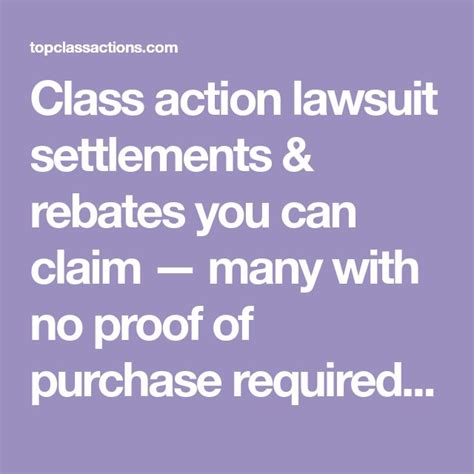Unlocking Compensation: Class Action Rebates Without the Hassle of Proof
When consumers feel wronged, whether through faulty products, unfair fees, or misleading advertising, they often wonder how to seek justice without incurring significant costs or complications. Class action lawsuits provide a means of collective redress, but for many, the prospect of gathering proof and navigating legal complexities can be daunting. Fortunately, there are simplified pathways to securing rebates from class action settlements that require minimal documentation or proof from the affected individuals.
Understanding Class Action Lawsuits
A class action lawsuit consolidates the claims of multiple individuals who share similar grievances against a company or entity. This legal approach enables consumers to band together, increasing their chances of receiving compensation and diminishing the burden of individual lawsuits. Common issues prompting class actions include:
- Consumer fraud
- Product liability
- Employment violations
- Data breaches
- Unfair or deceptive business practices
Class action settlements often promise refunds, rebates, or compensation to eligible parties. However, the traditional process can be convoluted, requiring evidence of individual loss, which can deter potential claimants.
The Challenge of Proof in Class Actions
One of the significant obstacles in claiming rebates from class action settlements is the requirement for proof. Individuals may need to provide receipts, transaction records, or other documentation to substantiate their claims. For many, this task is burdensome or even impossible, especially if records are lost or if they are unaware of their participation in a class action.
Moreover, time constraints and the complexity of navigating the legal system often dissuade individuals from pursuing their rightful compensation. Some may not even be aware that they are part of an ongoing class action, further complicating the claim process.
An Easier Path to Compensation
Recognizing these challenges, some class action settlements are evolving to allow more accessible claims processes. These initiatives aim to simplify the compensation journey by lowering or eliminating the need for proof. Here are several key features that these settlements may offer:
- Self-Attestation: Claimants can affirm their eligibility through simple self-attestation forms. This means they can claim compensation based on their word without needing to submit extensive documentation.
- Automatic Payments: In some settlements, automatic rebates are issued to individuals identified through existing data, such as purchase histories. This approach minimizes the need for claim forms altogether.
- Low Documentation Requirements: Some settlements may require minimal documentation, such as a brief form with basic purchase information, reducing the barriers to accessing rebates.
- Broad Eligibility: Expanding the eligibility criteria allows more individuals to benefit from the settlement, even if they were not fully aware of their claims.
These changes signify a more consumer-focused approach, aiming to ensure that as many affected individuals as possible receive the compensation they deserve.
The Benefits of Class Action Rebates Without Proof
1. Increased Access: With easier claims processes, more individuals can participate in class action suits, ensuring broader access to justice.
2. Faster Resolutions: Minimizing documentation leads to quicker payments, allowing individuals to receive their rebates promptly.
3. Focus on Justice: These streamlined processes underscore a shift toward prioritizing consumer rights and the spirit of justice over bureaucracy.
Getting Started with Class Action Rebates
To access class action rebates, individuals can follow these steps:
- Stay Informed: Regularly check resources like class action websites or consumer advocacy groups for updates on ongoing lawsuits and settlements relevant to you.
- Identify and Verify: If you believe you may be eligible for a class action rebate, verify your status by reading the settlement details and checking eligibility criteria.
- Complete the Claim Form: If the settlement requires filing a claim, do so as soon as possible, utilizing the simplified forms provided.
- Follow Updates: Monitor the status of your claim and stay informed about potential payouts or additional requirements.
Be proactive in understanding your rights and available compensation avenues, and remember that many consumer advocacy groups can provide assistance or guidance.
Conclusion
Class action rebates represent a powerful tool for consumers seeking justice and compensation for grievances. The evolution toward less stringent proof requirements demonstrates a commitment to ensuring that all affected individuals can access their rightful compensation. As awareness grows and legal frameworks adapt, consumers can look forward to a more equitable and streamlined process for reclaiming their losses.
FAQs
1. What is a class action lawsuit?
A class action lawsuit is a legal case filed by a group of people with similar claims against a defendant, usually a corporation or entity, for shared grievances.
2. How do I find out if I am eligible for a class action rebate?
Check class action websites, consumer advocacy groups, and legal forums to find information about ongoing lawsuits that might pertain to you.
3. Is there a deadline to claim my rebate?
Yes, each class action settlement typically comes with a deadline for filing claims, so it’s crucial to act promptly to secure your compensation.
4. Can I still claim my rebate if I don’t have proof of purchase?
Many modern class action settlements allow for simplified claims with minimal proof. Check the specific requirements for the settlement you are interested in.
5. What should I do if I believe I am part of a class action but haven’t received notice?
If you suspect you may be part of a class action suit, research the case online or consult a legal professional for guidance on your potential eligibility.
This HTML structure provides a comprehensive guide on class action rebates, detailing their significance, the challenges surrounding proof, and offering valuable insights for participants. The conclusion and FAQ sections help summarize key points while addressing common concerns.
Download Class Action Rebates No Proof
